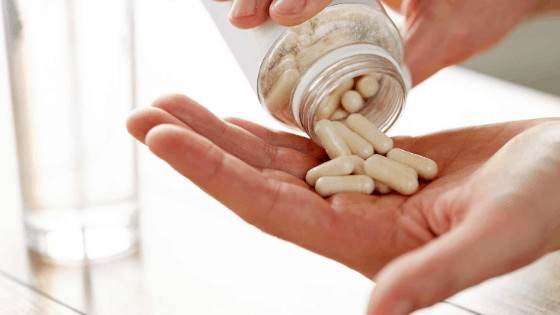
17 Dec How We Designed The perfect Multivitamin
Formulating and designing the best multivitamin supplement or any quality supplement isn’t for the faint of heart. At least the first one. I’m sure it gets easier as we continue to make supplements and get used to the process, but it has been a crazy busy time right now. I’m not going to go over all the background work about signing trademark agreements and all that mumbo jumbo. BUT, I am going to explain to you my process in how I decided what I wanted in Nuvitru’s Nutrition’s Multivitamin!
**The name may look different because we have rebranded to Nuvitru Wellness!!
You might think, “All you need is vitamin D, vitamin C, vitamin E, etc. and some minerals and throw the RDA (recommended dietary allowance on it”. Hm, not that simple.
First, the RDA of certain nutrients are the baseline of what you should have. The RDA doesn’t give you the amount for optimal health, just the amount to avoid diseases. Two, there are SO many different types of one vitamin. Some types are the cheapest, but least bioavailable source. Some types of more expensive, but really bioavailable. You’ll find the majority of supplement companies use the cheapest source of nutrients (that are the least bioavailable), but they can make more profit on it.
You’ll hear the world bioavailable a lot in this blog and it simply means – how much of the nutrient is actually absorbed + utilized in the body.
I didn’t create this supplement line to just create profit. As a business, profit is obviously needed to continue to do the work that I do, BUT I wanted to keep things as affordable as I possibly can. If you know me in real life, you know I hold that true to my heart.
Let’s start going through the list…
 Nutrients in our Multivitamin
Nutrients in our Multivitamin
Vitamin A – There are basically two forms of popular vitamin A supplements that you can use: retinyl palmitate or beta-carotene. Retinols are straight vitamin A that you get from animal products (we use this the best in our body). Beta-carotene actually is a precursor to Vitamin A. It needs to be cleaved in the intestines to break down to usable form vitamin A. It takes a little more effort to create the usable form of vitamin A.
Beta-carotene doesn’t build up in the body as quickly as retinyl palmitate can. Vitamin A can cause toxicity if there is too much build up in the body.
Since most of our population have no problems eating animal products and getting retinol sources, I thought the beta-carotene would be the best bet to avoid toxicity. Remember, a supplement is…..A SUPPLEMENT. I don’t recommend ever depending on a supplement for getting all of what you need in a certain nutrient.
Vitamin C – Most of the time you’ll find ascorbic acid in supplements for vitamin C. This is usually a synthetic form, but chemically structured the same way. Bioavailability is better when it comes from a whole food source due to there being other nutrients and phytochemicals that can help with the absorption of the nutrient we want. In this case, we want to utilize vitamin C.
In a study done in Nutrients, I love what they said in their results,
Although synthetic and food-derived vitamin C appear to be equally bioavailable in humans, ingesting vitamin C as part of a whole food is considered preferable because of the concomitant consumption of numerous other macro- and micronutrients and phytochemicals, which will confer additional health benefits.
This is why I decided to use acerola berry extract versus simple ascorbic acid. Acerola berry is one of the best sources of vitamin C (better than oranges).
Vitamin D – The best source of vitamin D is getting it from the sunlight, but our lifestyle has changed from getting out in nature all the time to being indoors. We also are always slathering sunscreen on our skin, which inhibits us getting vitamin D from the sun. In the Journal of American Osteopathic Association found that over 1 billion people worldwide has a vitamin D deficiency, especially African Americans + Hispanics.
When someone is deficient in vitamin D, you can’t take the recommended daily dose and expect your levels to rise to a “normal value”. We need to supplement more than the RDA to increase our levels.
I’ve taken 2500-5000 IUs throughout the week for almost a year now and my vitamin D levels are PERFECT.
I also used vitamin D3, instead of D2. Vitamin D2 is usually made from plants being in the sun and D3 is made by animals and D3 is the most biologically active for humans.
Vitamin E – When looking at vitamin E in supplements, you want to look for “d-alpha” not “dl-alpha”. When it’s “DL” before the alpha, that means it was synthetically made. “d-alpha” has a better 34% better bioavailability.
While there are 8 different tocopherols (alpha, beta, gamma, delta), alpha is the most potent.
In a study that was done by the Journal of American College of Nutrition, showed that d-alpha tocopherol succinate was the most effective form of vitamin E (especially for an adjuvant cancer treatment).
Vitamin K – In my supplement, I used vitamin MK-7. MK-7 is a type of vitamin K2 that stays in your body longer and works synergistically with vitamin D the best.
A study from the Nutrition Journal showed that MK-7 significantly increased blood serum levels of K2 (mores than MK-4) and is one of the most bioavailable forms of vitamin K. MK-7 is also the vitamin K that holistic dentists recommend for tooth decay. K2 activates osteocalcin, which helps rebuild bone tissue.
Most vitamin K in other supplements are from K1, which is the least bioavailable forms of vitamin K.
B Vitamins – We got the array of B vitamins, so you can throw your B-complex supplement away. 😉 Thiamine, B2, Niacin, B6, Folate, B12, and Biotin. Let me start off with my FAVORITE choices of B vitamins. The folate and B12. These nutrients are the ones that stand out to me the most when I’m looking at other supplements. Most supplement companies use cyanocobalamin for B12 and folic acid for folate. These versions are the cheapest to use in a supplement. Those versions of the nutrients are also the least bioavailable AND half of us can’t even take those nutrients to the next level where it’s utilized. Half of the population has a genetic mutation with their MTHFR gene – this is where our body’s ability to take folic acid to the usable form of folate is disrupted.
My mission for my supplements is to skip those internal processes when possible, so we have a ready available source of the nutrient. This is NEEDED for people that have gene mutations that affect that. I personally have the MTHFR gene mutation on my gene C677T.
Same with B12, I used the methylated form of B12 to give you that readily available source of the nutrient, so you are getting the most out of every. single. capsule.
Another B vitamin that I used the best version is B6. I used pyridoxal-5-phosphate (P5P).
P5P is the active form of B6. Just like B12 + folate, B6 has to go through a process in the body to convert to the active form of P5P. I want you to absorb and utilize this nutrient quickly and efficiently, so that’s why I chose the already active form. I took this same mindset with B2 and used riboflavin 5 phosphate, which is the ready and active form.
Iodine – The best version of iodine will always be in seaweed. Hence, why I used Kelp as the source.
Magnesium – To figure out which magnesium version is the best bioavailable one was the most challenging thing out of formulating this multivitamin. With as much research as I got into, I feel like I couldn’t get a clear answer. BUT, magnesium citrate always tended to be at the top with bioavailability compared to other versions.
I wanted magnesium inside the supplement, not only because it’s a cofactor to over 300 enzyme reactions, but it goes hand in hand with D3 and K2. You can think of them of being friends together! They work best together.
Magnesium has been shown to have better absorptive properties topically versus internally, so a magnesium spray could be beneficial as well!
Then, there are the other needed nutrients, such as pantothenic acid, zinc, selenium, copper, manganese, chromium, and molybdenum.
I also added in an organic whole foods blend! Because it’s not just the nutrients that take the spotlight in healthy foods, but the phytochemicals that add additional health benefits and help the absorption of the nutrients. There are so many aspects of a food that work together to give you what you need.
I also wanted to add in CoQ10! Now, this is a very expensive supplement. But, it’s much needed in everyone. CoQ10 is a fat soluble antioxidant that is needed in the electron transport chain to generate energy in the mitochondria (the center of cellular aging), helps prevent oxidation in LDL, and more.
The benefits of CoQ10 is amazing + supplementation of CoQ10 for people on statins are totally needed (at a much higher amount than 10 mg). I decided to use ubinquinol, instead of ubiquinone, because it’s 8x more bioavailable.
Other Ingredients – I wanted to keep things simple. All you’ll see is ‘vegetable capsule’ in our other ingredients. Clean as a whistle.
Why didn’t I include calcium or iron in my supplement?
Chris Kresser wrote an AWESOME article about calcium in supplements, which you can read here, but basically, I don’t recommend calcium in supplement form until you’ve tested your levels. Most people get enough calcium in their diet and doing MORE calcium than what you need can do more harm than good. This is a nutrient I wouldn’t want you supplementing with every single day, so I left it out of my formula.
Here is an excerpt from Chris Kresser’s article,
An analysis involving 12,000 men published in JAMA Internal Medicine found that intakes of over 1,000 mg of supplemental calcium per day (from multivitamins or individual supplements) were associated with a 20% increase in the risk of death from CVD. (6) Researchers suspect that the large burst of calcium in the blood that occurs after supplementation may facilitate the calcification of arteries, whereas calcium obtained from food is absorbed at slower rates and in smaller quantities than from supplements. (7) It is also suspected that extra calcium intake above one’s requirements is not absorbed by bones, but rather excreted in the urine, increasing the risk of calcium kidney stones, or circulated in the blood, where it might attach to atherosclerotic plaques in arteries or heart valves. (8)
The same idea goes for iron. Not everyone needs to supplement with iron because we can eat enough from good quality pasture-raised animals. This is another nutrient with that depends on delicate balance that I don’t think a daily supplementation is necessary for most.
So, those are my thoughts for our first multi-vitamin. And if I ever need to, I will make changes to keep this supplement up to date with the best multivitamin ingredients.
GET YOUR BOTTLE NOW


